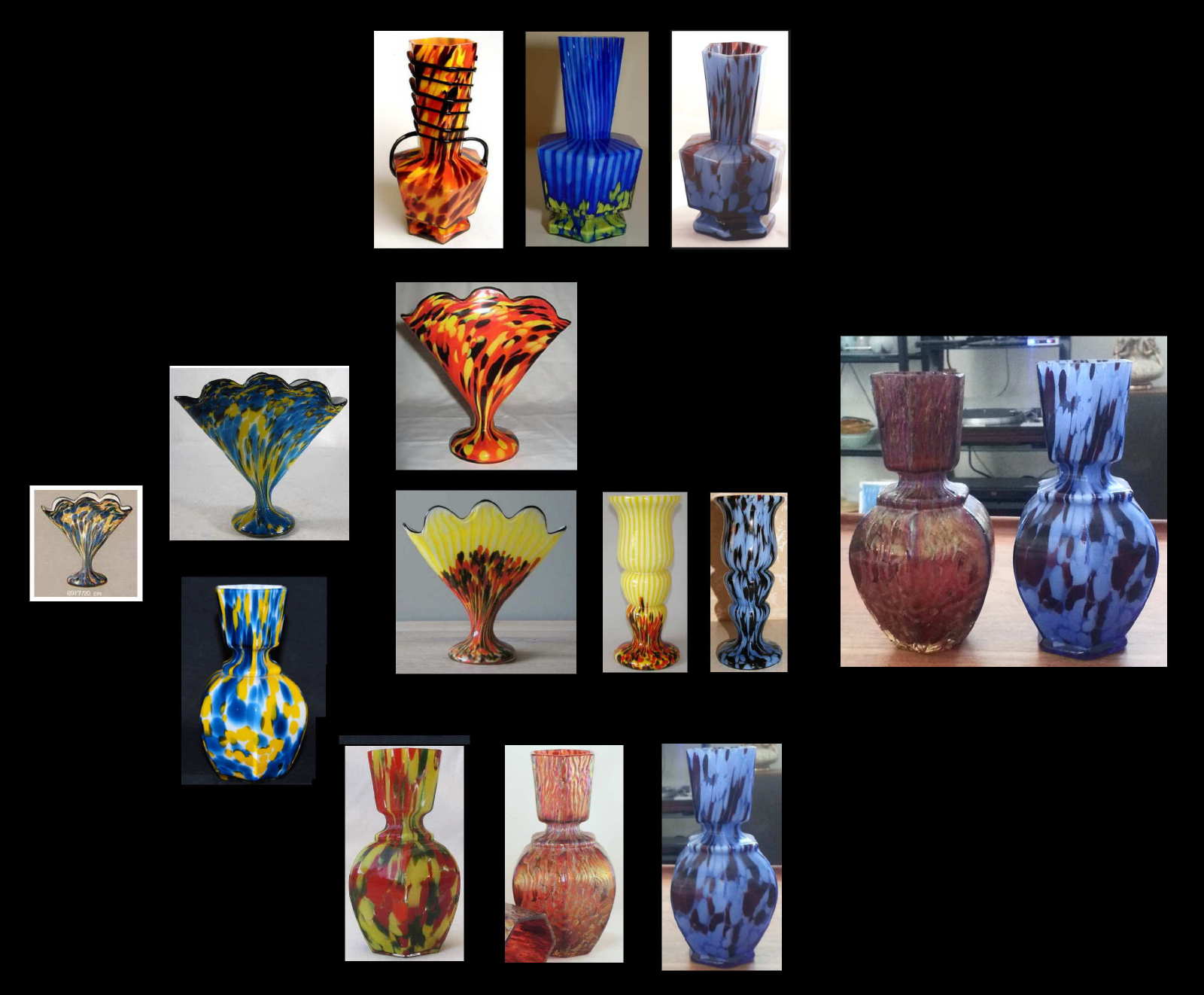Welz Maze Décor Research
A Highly Unexpected Answer to a Long Asked Question
by Craig Orkney
About 8 years ago, before I had even heard of Welz, I saw a very interesting vase in a shape that struck me as an Art Nouveau era piece of glass. A golden amber ground with patches of what appeared to be oxblood, and iridescent "patches" in it also. The iridescent patches reminded me mildly of the finish found on Knizek production… The body of the vase had a subtle surface texture which reminded me of a maze. The glass was unidentified, but I found it very fascinating and decided that it was a décor I would keep an eye out for; different example; different colors, and if possible at some point, an identification. Who knows why, but the décor fascinated me, and I saved some pics of it.
As time passed I saw a some examples in different shapes, and also an example in a light green ground.... and all the while, no one had any idea who actually made it. Lots of conjecture with no evidence… Jump forward a year or so and I purchased the Passau book set, “Das Böhmische Glas 1700-1950”, a 7 volume set in hardback. I started to examine the contents….. slowly, as it is in German, and in Band IV, Jugendstil in Böhmen, pg 224 image IV.392 I found the décor I had been wondering about for a while. The light amber color, in a shape I had seen before and recognized….. and I immediately knew this would be a tough one to figure out, as Passau had it as unknown production. The example is seen in the image below the following description.
-------------------------------------------------
The description in DBG reads:
Unknown Glassworks
Form and décor 1900-1910
Unsigned. Incorrect Signature “Loetz Austria” engraved on the base H. 25cm
Inv. Nr. Hö 55 510
Topaz colored glass, incorporating ruby red, silver and yellow voided frits, pre-blown in a meandering appearance. Mold blown and free formed, twice pressed body, two attached topaz yellow handles. Iridescent reduction. Edge ground flat.
In Passau Glass Museum identical vase executed in another form. (Inv. Nr. Hö 63 576) – Me.
-------------------------------------------------
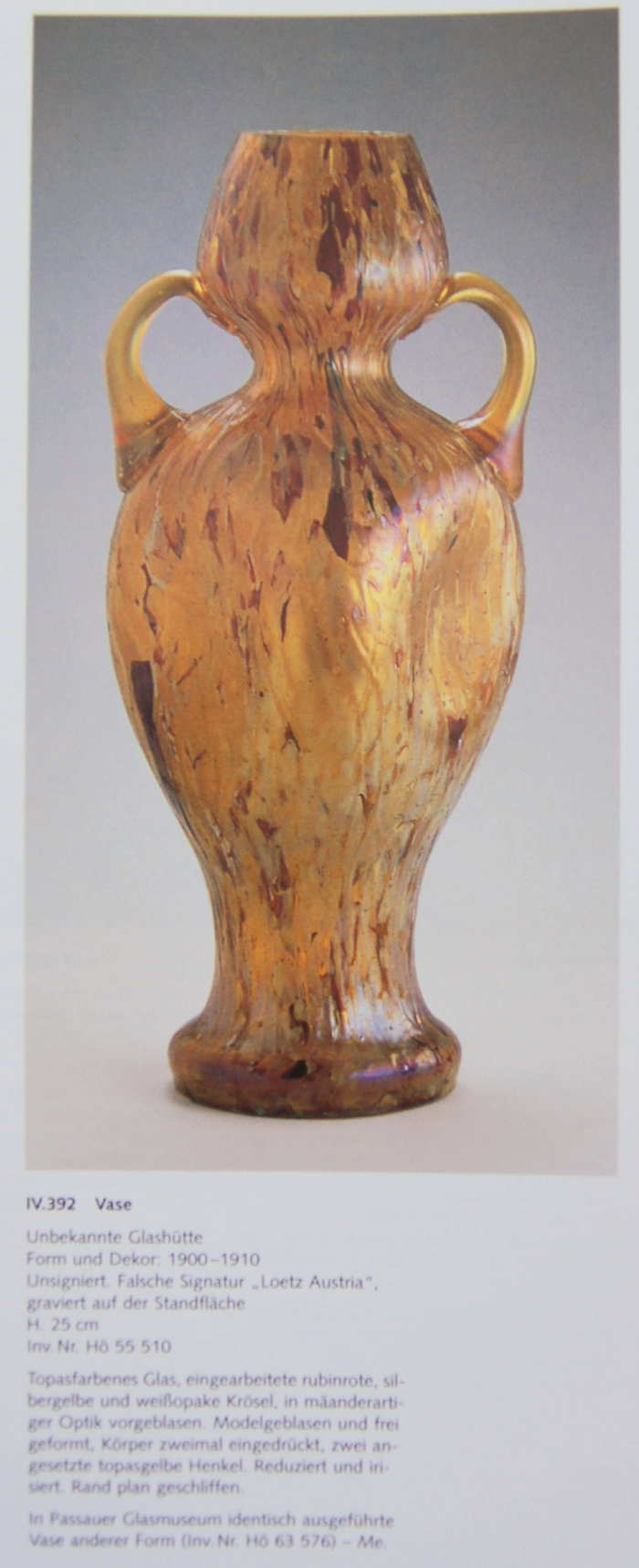
So there it was, a description which accurately represented the vases which had peaked my interest….. time ticked on…… I moved on….. and eventually caught the bug to do Welz research….. a line of research which has been my main area of concentration ever since. Once in a while I would see another piece of the unknown Maze production and still, no one knew what it was. I also noted through time, that there were at least a couple of variations of the surface texture of the Maze style of décor I was seeing. I knew that there were at least a couple of houses that produced a similar décor. The other examples I saw showed differences in the “strength of pronunciation” of the décor on the surface, and none of the other similar patterns appeared in the style of glass that accompanied the examples that I found so interesting.
My Welz research progressed for many years, and over time I uncovered some “families”, or groups of related shapes. One of the families of shapes that I found most interesting was a very unique group based on hexagonal bodies and rims. Some curved forms, some straight forms, but a group of shapes sharing the hexagon as a common design theme.
As I continued doing Welz research, an occasional conversation or post occurred in different forums regarding the décor I was fascinated with, and the result was always the same….. No one knew who made it. Nothing really “solid” came along until an example of the décor was identified in a Collectors forum as Steigerwald. I was excited that it may be the ID I had been looking for, so I examined the possibility and could find nothing to support the Steigerwald attribution. Interestingly though, it was the same form and color as seen in DBG. So I left it as “unknown” in my mind, and moved on. My now almost 6 year long infatuation with the décor seemed doomed to anonymity, and I was OK with that. We certainly will never identify all of this glass. Regardless of who made it, I thought it was as outstanding décor!
The following image shows some of the variations I encountered over the years.
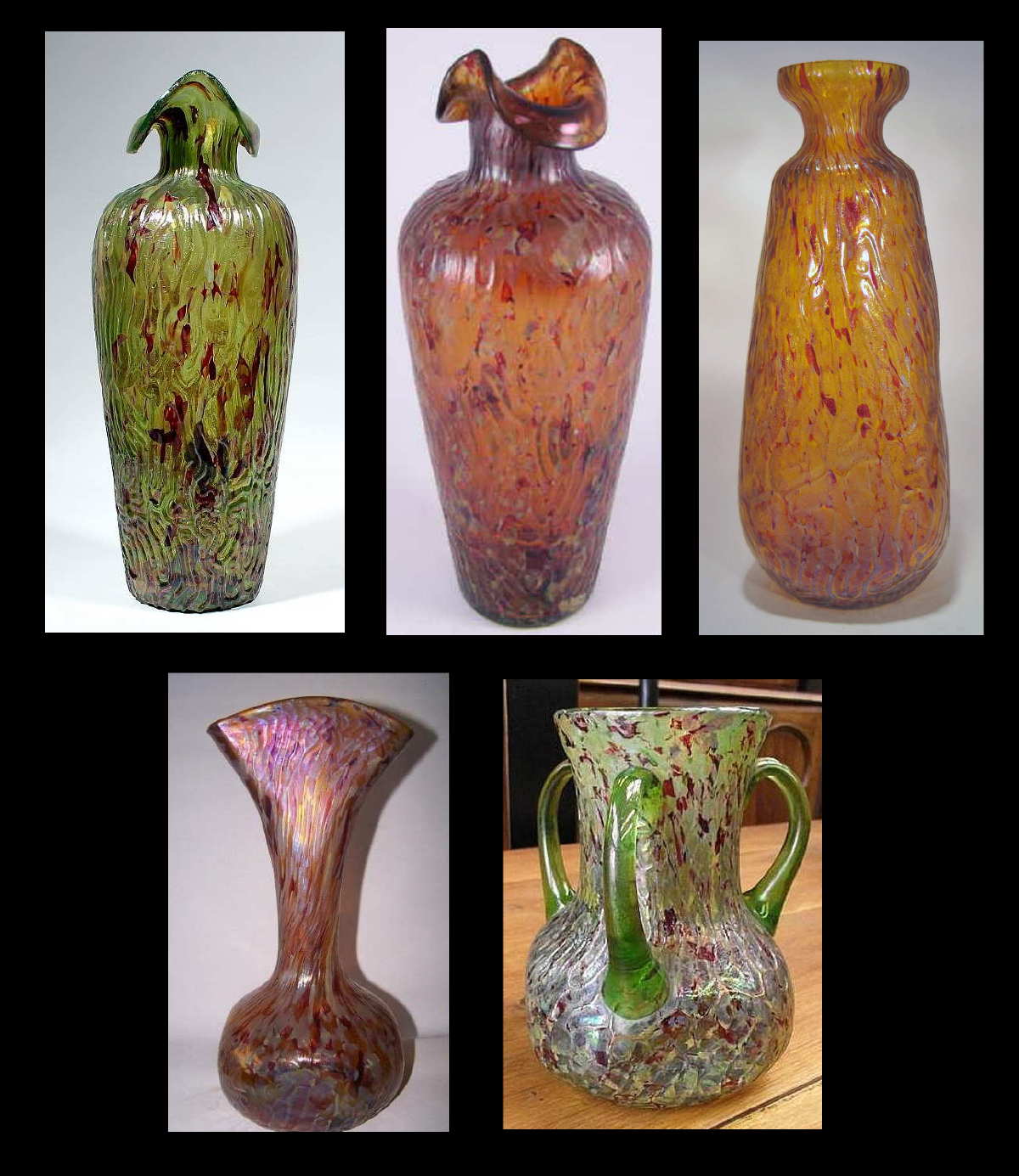
As my research of Welz production broadened from Deco Era style décors to glass commonly identified in the UK as English cottage glass, a portion of which have turned out to be Welz production, I noticed a particular characteristic of some distinctive spatter décors. That characteristic was that where spatter décors identified and attributed to other companies were made of up of “smeared splotches” of color, many of the Welz spatters had colors in the décor which looked more like ripped or torn pieces of paper. These “pieces” of color reminded me of a crafting technique referred to as decoupage, where torn or cut paper is glued down to form a colorful image. I now refer to spatters which exhibit this distinctive trait as “decoupage spatters”. The significance of this would become apparent to me later. At the time it really only seemed to relate to a style of product which was exported to the UK by Welz. It was also a technique which could be found on a limited basis, in more colorful Welz Deco Era production of the 20’s and 30’s.
Over time I dug deep for Welz information… not only for examples of glass, but for any historical information regarding the Welz family. As I developed an idea of their production, and gained an appreciation for their very colorful and unique aesthetic, my interest evolved from merely identifying glass, to a fascination with a family that seemed to have been largely overlooked and forgotten in the annals of glass history. My questions grew to include not only “what they made”, but “who were the people that made this glass”. Where were they from, and where did they go? After about 7+ years of trying, and as a result of a very odd set of circumstances one day, I made contact with the husband of the great grand daughter of Franz Alois Welz….. and within a few minutes of the contact I was provided with a scan of a piece of Welz production literature! To say I was excited is a gross understatement…. My neighbors probably heard me yell when I saw it….. and at the same time I was completely amazed. I realized that what I had been provided with was an historically important document. Something that at that time was not known to exist, and to that point in time had never been seen in the glass world….. This was in Oct 2014, about 7.5 years after my Welz research had started.
I do have to say that the family has been of great help, and have provided me with access to, and images of, historically important documents pertaining to Welz in Klostergrab. They are also quite thrilled to know that the history of the family and the glass they produced is of great interest to someone who has taken on the project of researching it. I pay my utmost respects to them, and also to a contact in the Czech Republic who grew up in Hrob (Klostergrab) and has been of enormous help in uncovering information regarding Welz after the turn of the century. He is also glad to know that the history of his hometown is being examined.
I digress….. The best part of seeing the production literature was that it not only provided some documentation of Welz glass output, it also confirmed with factory literature, a number of the shapes and décors I had previously identified as being Welz. Most importantly, at least to me, was that it provided proof that the methods I had been using for Welz research were apparently both effective and accurate. Where glass has always been a fascination of mine, research to this extent is not something I had done before. The methods I have been using are a combination of things I have learned from other respected researchers, and some methods I developed myself.
In one of the pieces of literature I was also glad to see a small vase in a décor and shape I had identified as Welz. I actually owned the piece shown. As importantly, it also seemingly confirmed my suspicion, (which I really knew already) that the family of hexagonal shapes I had been studying were a group of shapes definitely produced by Welz. I had included in that family of hexagonal shapes, through the use of several distinctive décors, a number of similar examples I felt were also Welz production.
The shape in the Welz literature is shown as shape 7257 and specified as 11cm, or about 4.3 inches tall. Many of the other examples I have found in this family are also examples about that height. I have also found examples in the shape family which stand at approx. 6.5 inches in height. So it appears that the shapes were made in two heights. Some examples in my own collection are examples of the same shape in the two different heights. So my Welz research had progressed at a slow and steady pace to reveal some outstanding findings. This family of shapes is seen in the following image.
The “7257” family of shapes shown here includes not only examples in my collection, but also examples in the collections of generous collectors from around the world willing to share information to further Welz research. An interesting note is that the small oil lamp in the green honeycomb décor also displays the same foot as the Oxblood & Blue examples. The basic size of this is the same as the larger vases, as the green honeycomb lamp measures 4 inches to the top of the hexagon at the top of the body, and that is the same dimension as my Oxblood and Blue example.
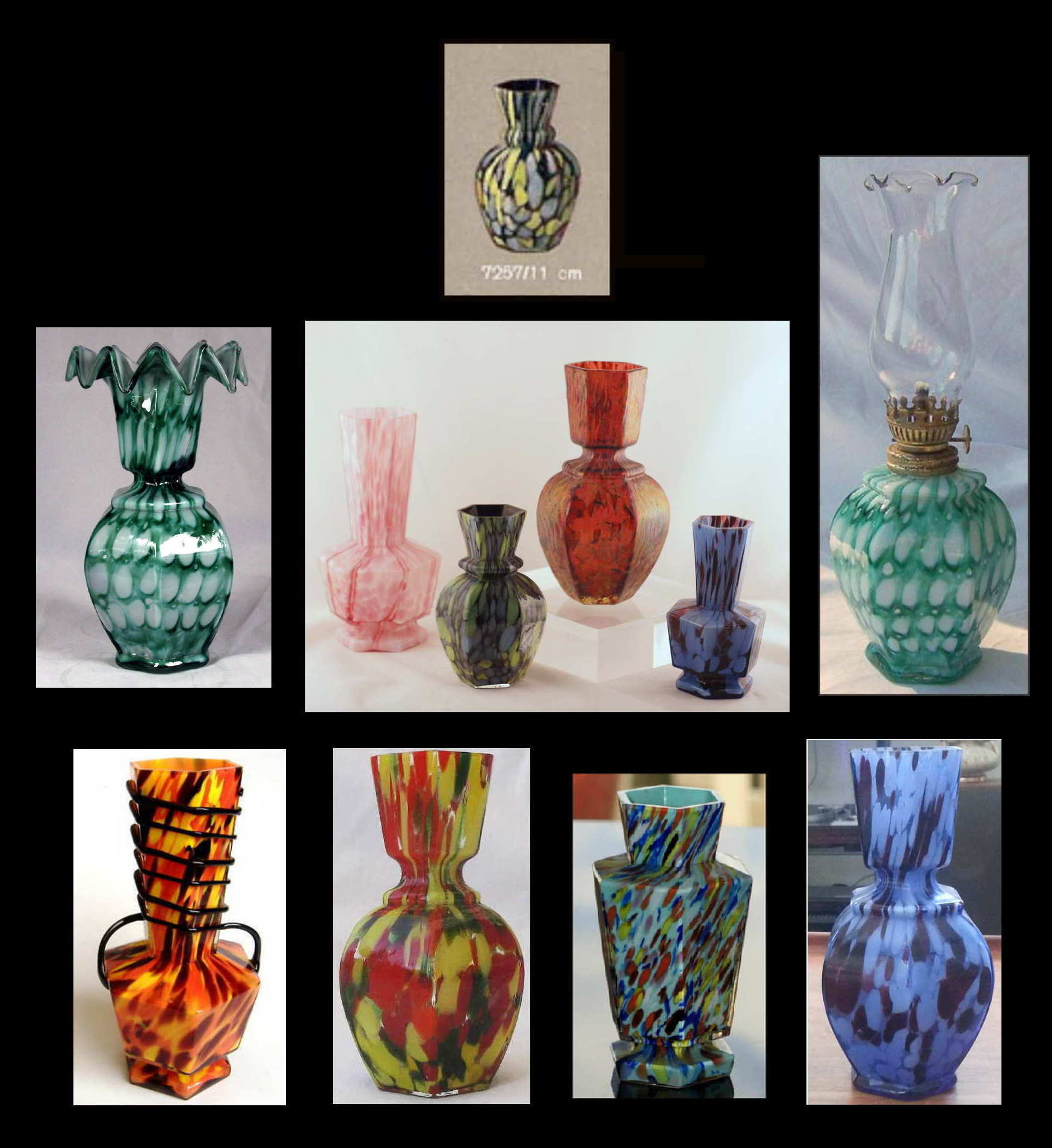
Now…. Let’s rewind the clock a little bit.
A couple of years ago a friend posted a pair of vases in Collectors Weekly she had purchased. On seeing the post I could not believe my eyes. The extremely distinct shape of the vases was actually one I had classified as Welz production. Her pair were 6.5 inches tall, and I had only seen the shape in a 4.3 inch version. I had owned it in a Welz décor I refer to as “Oxblood & Blue”, but had unfortunately lost it in the “great shelving collapse”. My small example had a foot added to the mold, but was quite obviously the same shape. The most amazing and startling thing about her pair was that they were in the Maze décor I had been enamored with for at least 6 years. One thing led to another, and the pair of vases ended up in my collection as the result of a great act of kindness and generosity. An examination of the vases coupled with a review of saved images of examples, revealed to me a detail which stopped me dead in my tracks. I was kind of dumbfounded I had not paid that much attention to it previously. The detail was that the splotches of color in the maze décor vases appeared to be produced using the same technique as the “Decoupage Spatter” I had previously associated with Welz production. I also noticed this pair had a very light cranberry ground. I had only previously seen the vases in amber and light green grounds. The pair she posted are in the following picture.
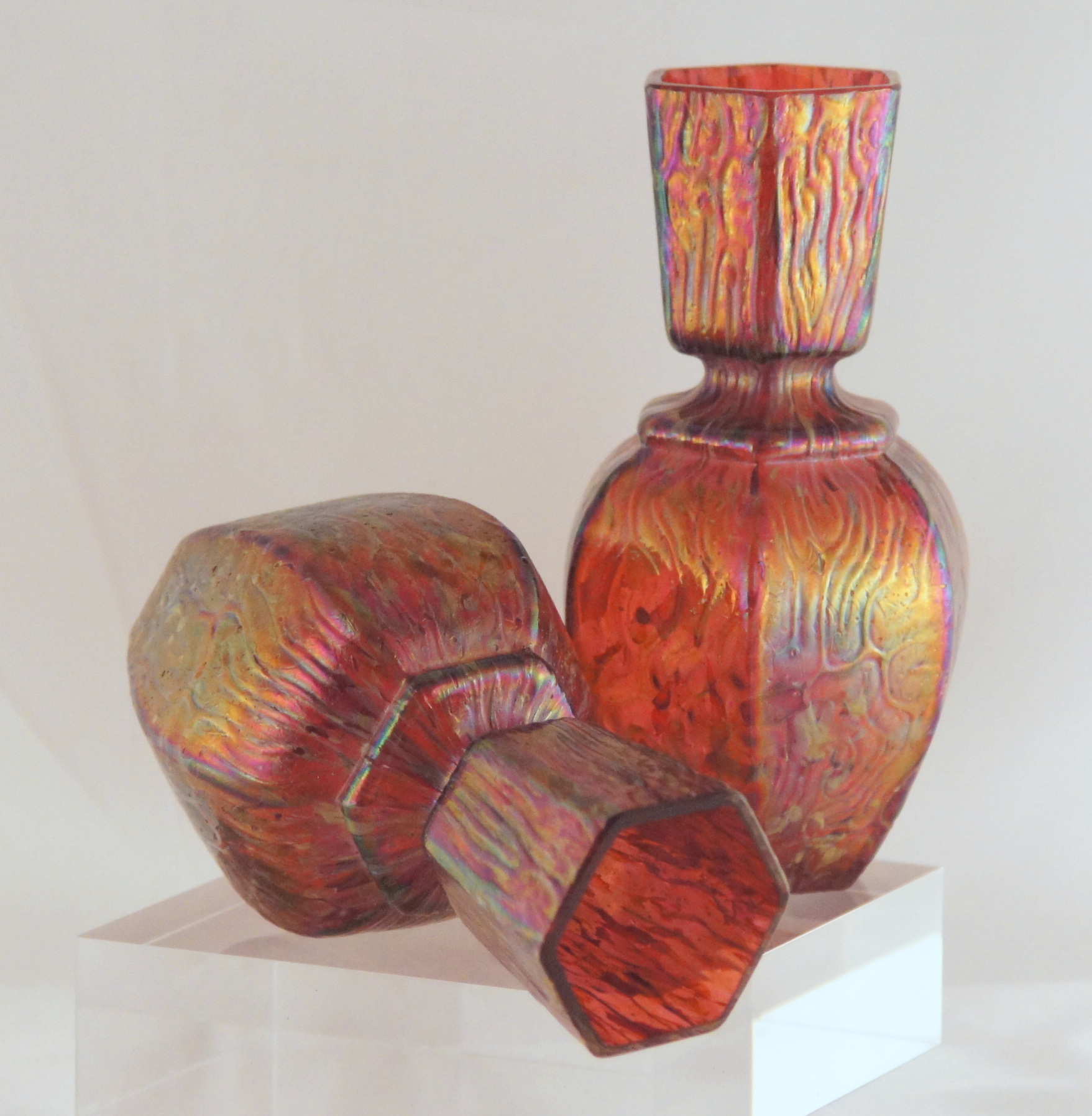
At the time I received the vases I was quite convinced that I had inadvertently found the answer to the question I had been wondering about for many years….. but the last piece of the picture was still missing…. At least for me….. The examples of this shape I had seen were all of the 4.3 inch examples. I also had the 4.3 inch example in the Oxblood & Blue décor… and one small difference was that the Oxblood example had a small foot at the bottom of it. This was a difference I simply attributed to a slight mold variation. I had also seen the 4.3 inch version of the same shape as the Maze vase pair in another known Welz décor without the foot, so I know the 4.3 inch version came both ways….. and the vases took their place….. front and center in my collection… and not just my collection of Welz…..
And then came 5/20/2015….. and while I was working on a construction project at our house, my wife Peggy decided to go to local Goodwill. Upon return she showed me a couple of things she had purchased, and then placed a crumpled brown paper bag on my desk with a smile, and said… I also got this for $1.... and I opened it up. WOW!!
First of all it was Welz!! It was $1! It was mint! It was in the Oxblood & Blue décor! It was large (6.75 inches)!! And the final and most important thing….. It was the shape of the Maze décor in the same height….. and like the smaller version I had lost, it also had the foot…..
So, although I already knew the décor was by Welz, I finally had a 6.75 inch example in another known Welz décor in the same size. A close examination reveals that the vases are pretty much the same mold. Same mouth size, same body dimensions… The only difference is that the Oxblood example is .25 inches taller, the thickness of the foot added to that mold.
There is absolutely no doubt in my mind that the maze décor examples and the Oxblood example came from the same factory. There is also no doubt in my mind, that the factory that produced them was the factory owned by Franz Alois Welz.
I can rest assured, that my 8 year search has ended and I have the answer to the question I was looking for. Did I ever think the Maze décor was Welz? Absolutely not. I never even suspected it. But that is how many of the answers in my research have come to me….. a tidbit here and a tidbit there….. all of which mean nothing by themselves, but they all come together in one instant to reveal an answer I had no idea was coming.
Many people that know me tell me that they do not have the personality or patience to do research… it is too monotonous, and too time consuming, and takes far too long in many instances. In many cases it leads nowhere, but the rewards of doing research are ones like this. An instance where an answer presents itself….. and it is completely unexpected. Does it seem like an 8 year search? Not at all. It simply seems like a little journey appreciating some glass… a journey that resulted in an unexpected, but solid answer to a question I had almost forgotten I was asking…..
So there you have it…. My conclusion.
A Welz Maze décor in a decoupage ground, and currently known to have been produced in three colors.
The last image below is a small “representative” image of the type of “roadmap” I use to confirm some Welz production. This represents very simply, some of the types of relationships I establish with shapes and décors. In most cases I like to see multiple shapes and multiple decors to confirm any one ID. In the case of this “family tree”, I was able to put it together as an example using a factory production image as a starting point. This is also a much simpler version than what I generally do. In many cases the starting point is an example of production I am absolutely sure is Welz. In many cases in my research, marker décors and/or marker shapes are the starting points.
